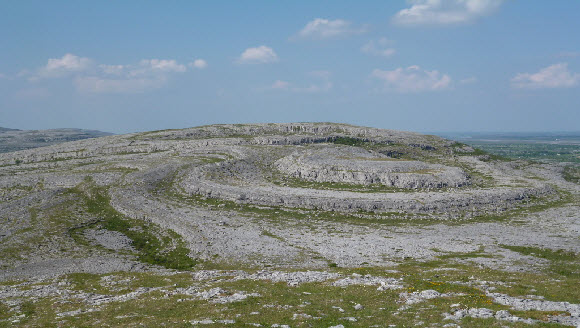Protection of the Burren
The Burren is a vibrant living landscape, with outstanding cultural and natural heritage. The area is internationally important for ecology, botany, geology, speleology, archaeology and agriculture.
The exposed limestone terraces and pavements of the Burren uplands and hills have light, free draining soils and subterranean water drainage. Land use traditions, unchanged for thousands of years, are practiced here to this day. The Burren is evidence of an ancient agricultural and a pastoral farming economy. Early field systems and habitation sites among other field monuments, are uncommonly well preserved on the landscape’s surface.
The distinctive karst landscape contains over 70% of Ireland’s native flora and is host to a mosaic of significant habitats which have been formed and sustained through human interaction and farming practices. The Burren and its remarkable limestone geology is a source of great inspiration resulting in a rich cultural legacy as shown by people through art, music and literature. Reverse-transhumance pastoralism, known as ‘winterage’ is the most effective and appropriate use of the seemingly barren karst environment.
Over recent decades, multiple heritage conservation projects have been implemented in the Burren region, which exemplify the type of synergy between education, awareness raising, legislative mechanisms and support that bring about a positive and enduring impact on the heritage landscape. Below is a list of positive initiatives led by a variety of stakeholders.

The Burren
The Burren's special character, arising from the complex interaction of geology and physical landscape, natural scenic beauty, wildlife, a wealth of historic and prehistoric monuments, and local culture make it one of Europe's most unique landscapes. In order to ensure the protection of this natural resource, on which Burren tourism depends, a coordinated approach to visitor management and environmental protection within the Burren is required.
The Burren and Cliffs of Moher UNESCO Global Geopark
The Burren and Cliffs of Moher UNESCO Global Geopark (formerly the Burren Connect Project) has attracted EU Life funding and a partnership between conservation and tourism interests in the region to develop policies, models and standards in sustainable tourism destination development. For further information visit Burren Geopark.
Burren ecotourism network
B.E.N. is a network of tourism enterprises with the objective of establishing the Burren as a premier internationally recognised sustainable tourism region. It seeks to support continued training, mentoring and accreditation in sustainable tourism for its members and for businesses interested in joining the Network. For more visit Burren ecotourism network. In 2021, the Burren Eco Tourism Network has won a Lonely Planet award in its 'Best in Travel' picks for 2021.
Burrenbeo Trust
Burrenbeo Trust is dedicated to connecting all of us to our places and our role in caring for them. The trust engage with local and visiting communities to generate a sense of informed pride in their heritage and landscape, both with students and educators. They carry out educational events and festivals on heritage and landscape and work towards sustainable management of the Burren through community-led conservation projects.
The Burren community charter
With the support of the Heritage Council, Burrenbeo Trust have acted as lead partners on the Burren community charter Project with other Burren agencies and local authorities. Research was conducted through meeting people on the ground and gaining an insight into the needs and wants locally in order to devise a strong community whereby people could live, work and socialise in the Burren.
The Burren programme
started in 2016 and is a progression from the Burren Farming Conservation Programme (BFCP). Taking a longer term view the programme is the outcome of an important, long-term policy and practical initiative to understand and sustain the role of farming in supporting the value and diversity of the natural and cultural heritage of the Burren. The Burren Farming for Conservation Project (BFCP) which ran from 2010- 2015 emerged from the BurrenLIFE Project (2005-2010). The BurrenLIFE project was the first major farming for conservation project in Ireland and one which placed farmers at the centre of the conservation agenda, with the support of the Burren branch of the Irish Farmers Association (IFA).
In turn the BurrenLIFE programme built on research in the 1990s which highlighted the important role that farming plays in supporting the rich biodiversity and cultural heritage of the Burren and also the breakdown in traditional farming systems and the habitats dependent on them (Dunford 2001). In 2004 the National Parks and Wildlife Service, Teagasc and the Burren IFA secured EU LIFE funding to address some of the problems identified in the initial research and the sustainable agricultural management of the Burren. The BurrenLIFE project worked with 20 Burren farmers in an area extending over 2,500 ha to test and develop a blueprint for a specific approach to farming and conservation on the Burren.
The Burren national park
The Burren national park is located in the south-eastern corner of the Burren and is approximately 1500 hectares in size. The land was bought by the Irish Government for nature conservation and public access. It contains examples of all the major habitats within the Burren; limestone pavement, calcareous grassland, hazel scrub, ash/hazel woodland, turloughs, lakes, petrifying springs, cliffs and fen.
Page last reviewed: 10/03/22
Content managed by: Heritage unit (within Planning department)
Back to topContact
Áras Contae an Chláir
New Road
Ennis
Co. Clare
V95 DXP2
(065) 684 6407
This is just for feedback on our web site, not comments or questions about our services.
To tell us about anything else, go to our contact us pages.
